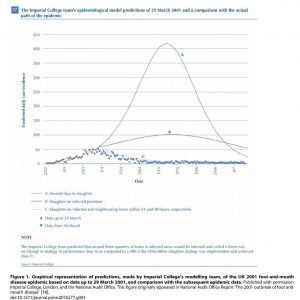So there’s been a lot of talk about Neil Ferguson’s history of alarmism, including his work on BSE, foot and mouth and swine flu. What I’d like to do here is to crowd-source some information. If anyone has any has any more knowledge or recollections or links about how he has performed in the past, please add them in the comments. (Defences of Ferguson welcome too, this is supposed to be objective.)
Here’s a little graph to get you going. It concerns foot and mouth policy, where Ferguson and his collaborators advocated a radical slaughter policy, which they claimed was borne out by the results after it was enacted, but others strongly disagreed (click to enlarge):
Christley, Rob & Mort, Maggie & Wynne, Brian & Wastling, Jonathan & Heathwaite, Ann & Pickup, Roger & Austin, Zoe & Latham, Sophia. (2013). “Wrong, but Useful”: Negotiating Uncertainty in Infectious Disease Modelling. PloS one. 8. e76277. 10.1371/journal.pone.0076277
(Not a paper I recommend reading).

10 thoughts on “Crowd-sourcing a Ferguson history”
“We show that the discourse of uncertainty in infectious disease models is multi-layered, flexible, contingent, embedded in context and plays a critical role in negotiating model credibility. We argue that usability and stability of a model is an outcome of the negotiation that occurs within the networks and discourses surrounding it.”
I guess that kind of writing is why most of us are not going to get past the Abstract. It is delicious, in the Upper Class English sense of the word, that the co-author of a paper about the slaughter of millions of animals is Ms. Mort.
“We show that the discourse of uncertainty in infectious disease models is multi-layered, flexible, contingent, embedded in context and plays a critical role in negotiating model credibility. We argue that usability and stability of a model is an outcome of the negotiation that occurs within the networks and discourses surrounding it.”
Love it! In plain English;
“Putting poor quality data into a computer model with exponential functions results in the biggest pile of bullshit you could possibly imagine”
This bit is important;
“We contend that rather than being based predominantly on beliefs about quality, the usefulness and authority of a model may at times be primarily based on its functional status within the broad social and political environment in which it acts.”
Which I would simplify to; we know it’s bullshit, but it’s useful for propaganda purposes.
Perhaps someone else can dig out stuff on Ferguson’s contribution to the mad cow fiasco. On foot&mouth I found two interesting papers.
https://www.research.ed.ac.uk/portal/files/14288330/Use_and_abuse_of_mathematical_models_an_illustration_from_the_2001_foot_and_mouth_disease_epidemic_in_the_United_Kingdom.pdf
https://doc.oie.int/seam/resource/directMedia/i6dc09blQD1AGdh92PTqZe6mgcoAE1vA;jsessionid=8d0131cb7395547db4c8c896e2fe?binaryFileId=10706&cid=2362
As far as I can see from the graph the outcome was a reasonable approximation to the prediction.
Of course it seems likely that a similar or better outcome could have been achieved by less drastic means. Did other countries get similar or better outcomes without all the killing?
https://www.fr24news.com/n24/2020/03/neil-ferguson-the-scientist-who-convinced-boris-johnson-of-the-coronavirus-lock-in-the-uk-criticized-in-the-past-for-his-erroneous-research.html
I can’t find, in Ferguson’s report, any indication of the number expected to be infected under his various scenarios. I assume that must account for the wide spread, from a few thousand for the “We make the Gestapo look good scenario” up to half a million dead for the “do nothing scenario”, because his paper explicitly states that that top end projection is _independent_ of any impact of limited health care resources. In English, he seems to be saying the death toll would actually be much higher for “do nothing” as people with serious but treatable symptoms will die if there aren’t beds and ventilators (which is obviously true).
So they must be aiming at reducing the final tally of infections, something that could only happen if the virus is eliminated. That would only be possible with many months to years of the current measures, or hypothetically, with some weeks of everyone totally and individually isolated (which is impractical for obvious reasons).
How any of this can be even guessed at in the absence of a reasonable estimate of the number who are infected, who knows.
Relying on an imperfect memory, yes. Didn’t the Dutch, and others on the Continent, opt for vaccination?
Apparently the numbers were already dropping before the ‘total wipeout’ started.
Yes, and I strongly suspect this is what is happening with C19. They are miles behind the wave and the vast majority of it is undetected.
That’s why these ‘exponential’ graphs of infection are nothing of the sort, they are simply reflecting an exponential increase in testing showing a problem that was already endemic.
This is the fundamental flaw in the approach from Ferguson etc. They believe they can contain and eradicate a highly infectious disease in a highly mobile and connected world. Fuel that with ‘computer models’ that are nothing more than mathematical masturbation, and you get a world wide catastrophe.
The first rule of medicine is to do no harm. This is a medical treatment being applied to an entire country, yet there is not a shred of clinical evidence to support the treatment.
Looking at the graph the actual numbers approximate to a bell curve with the peak at the start of intervention. So it could be that the intervention did nothing or it could be that it worked.
You’d need evidence from elsewhere to know.
BTW it is my recollection that only the UK went for slaughter and shutting down the countryside, everyone else solved the problem by vaccination.
These people do seem to like dramatic solutions!
Comments are closed.